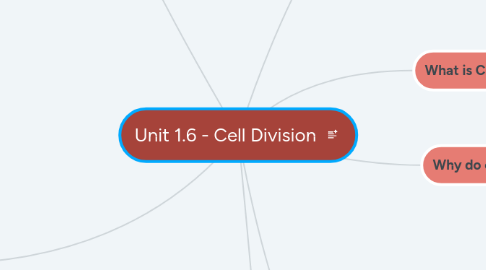
1. Phases of Mitosis
1.1. 1. Interphase
1.1.1. Chromatin not visible and DNA, Histones and centrioles are all replicated
1.1.2. Interphase happens before mitosis
1.2. 2. Prophase
1.2.1. - chromosomes condensed and visible - centrosomes at opposite poles of cell - nucleolus disappears - phase ends with the breakdown of the nuclear membrane - sister chromatids are joined in the centromere
1.3. 3. Metaphase
1.3.1. - sister chromatids align along equator of cell - spindle fibres ( microtubules ) connect centromeres to centrosome
1.4. 4. Anaphase
1.4.1. - Centromeres split, allowing sister chromatids to separate into 2 sets of chromosomes - chromatids move towards poles, centromeres first, pulled by kinesin proteins walking along microtubules
1.5. 5. Telophase
1.5.1. - spindle fibres disperse - nuclear membranes form around the chromosomes - nucleoli form - Supercoiling unwinds - chromosomes de-condense
1.6. 6. Cytokinesis
1.6.1. - in animal cells a ring of acting filaments form around the equator of the cell and then tightens to form a cleavage furrow which splits the cell in two - in plant cell vesicles move to the equator and line up and fuse to form two membranes called the cell plate. A new cell wall is laid down between the membranes
2. Types of Cell Division
2.1. Mitosis
2.1.1. Division of the nucleus into two genetically identical daughter nuclei
2.2. Meiosis
2.2.1. A process in cell division during which the number of chromosomes decreased to half the original number. it occurs by two divisions of the nucleus and results in the production of 4 sex cells ( gametes )
3. three phases in interphase
3.1. G1
3.1.1. the first growth phase, following cytokinesis in which the cell grows and prepares for DNA replication. More organelles are produced in this phase
3.2. S
3.2.1. the synthesis stage in which DNA is replicated
3.3. G2
3.3.1. The second growth phase in which the cell finishes growing and preparing for mitosis
3.4. M
3.4.1. the production of two genetically identical nuclei and finally cytokinesis
3.5. C
3.5.1. the cytoplasm splits and the contents of the cell are divided into two new cells
3.6. Cylcins
3.6.1. are molecules that are involved in controlling the cell cycle. They interact with proteins and control the cycle by controlling specific events ( spindle formation, alignment, etc.)
4. What is Cell Division?
4.1. the process by which a parent cell divides into two or more daughter cells
5. Why do cells divide?
5.1. Cells must divide to perform functions such as growth of organism, replacement of damaged or old cells, and asexual reproduction in some organisms
5.2. cells are limited in size by their surface area and volume ratio
6. Mitonic index
6.1. Mitotic index is defined as the ratio between the number of cells in a population undergoing mitosis to the number of cells
6.2. the purpose of mitotic index is to measure the rate of cell division
6.3. Mitotic index : cells in prophase, metaphase, anaphase, telophase / total number of cells
6.4. Cancer/Tumors
6.4.1. the mitotic index is a crucial factor in predicting both overall survival and response to chemotherapy in most types of cancer
6.4.2. mitotic index simply measures the percentage of cells undergoing mitosis. durations of the cell cycle and and mitosis vary in different cell types.
6.4.3. an elevated mitotic index indicates more cells are dividing and so indicates cancer cells
7. Replication of chromosomes during the synthesis stage of mitosis
7.1. homologous chromosomes
7.1.1. - homologous chromosomes contain the same sequence of genes and have the same structure and they pair during meiosis
7.2. crossing over
7.2.1. process in which homologous chromosomes exchange portions of their chromatids during meiosis. This increases genetic variation
7.3. Replication
7.3.1. chromosomes duplicate before dividing in meiosis
